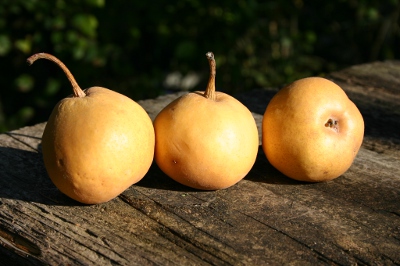︎︎︎ PERA DI BURRO

La pianta madre è stata rinvenuta a Gualdo Tadino (PG); la sua origine è sconosciuta e non sono state trovate altre piante del stessa varietà. L’albero è mediamente vigoroso e molto rustico, a chioma espansa, produce in maniera costante e fiorisce tardivamente. Questa pera è di medie dimensioni, ovoidale corta, allargata alla base, con il peduncolo corto, grosso inserito in una cavità media. La cavità calicina è piccola e poco profonda. La buccia è spessa di colore di fondo giallo, totalmente coperta di ruggine. La polpa è bianca, succosa e totalmente priva di granulosità (burrosa), molto zuccherina e profumata. Di ottima qualità. Si raccoglie in ottobre e si conserva per circa due mesi in fruttaio, anche appesa in corone. Viene anche chiamata pera Nera per il suo aspetto totalmente rugginoso scuro.
E’ adatta alla essiccazione per l’ottima qualità della polpa, ma anche alla cottura al forno. Una volta essiccata può essere conservata in sacchetti di cotone in un luogo arieggiato, e utilizzata nei piatti a base di pesce; ad esempio messa a cuocere con il baccalà al tegame.
The mother plant was recovered in the area of Gualdo Tadino (Perugia); its origin is unknown and no other specimens of the same variety were found. The tree is vigorous and quite rugged, with spreading crown. It crops regularly and blooms late. This pear is medium, egg-shaped and short; it has a wide base. The stem is short, thick and inserted in a medium cavity. The calyx is small and not too deep. The skin is thick, with a yellow background entirely covered with russeting. The flesh is white, juicy and buttery (not at all granular). It is very sugary and aromatic. It is of very good quality. It is harvested in October and preserved for about two months in the fruithouse, even hung braided. It is also called pera nera (black pear) for its dark russeting covering its skin. It is suited for drying due to the high quality of its flesh but also for baking in the oven. Once dried, it can be preserved in cotton sachets in a ventilated place. It can then be cooked with seafood dishes such as pan-fried Baccala (dry salted cod fish).